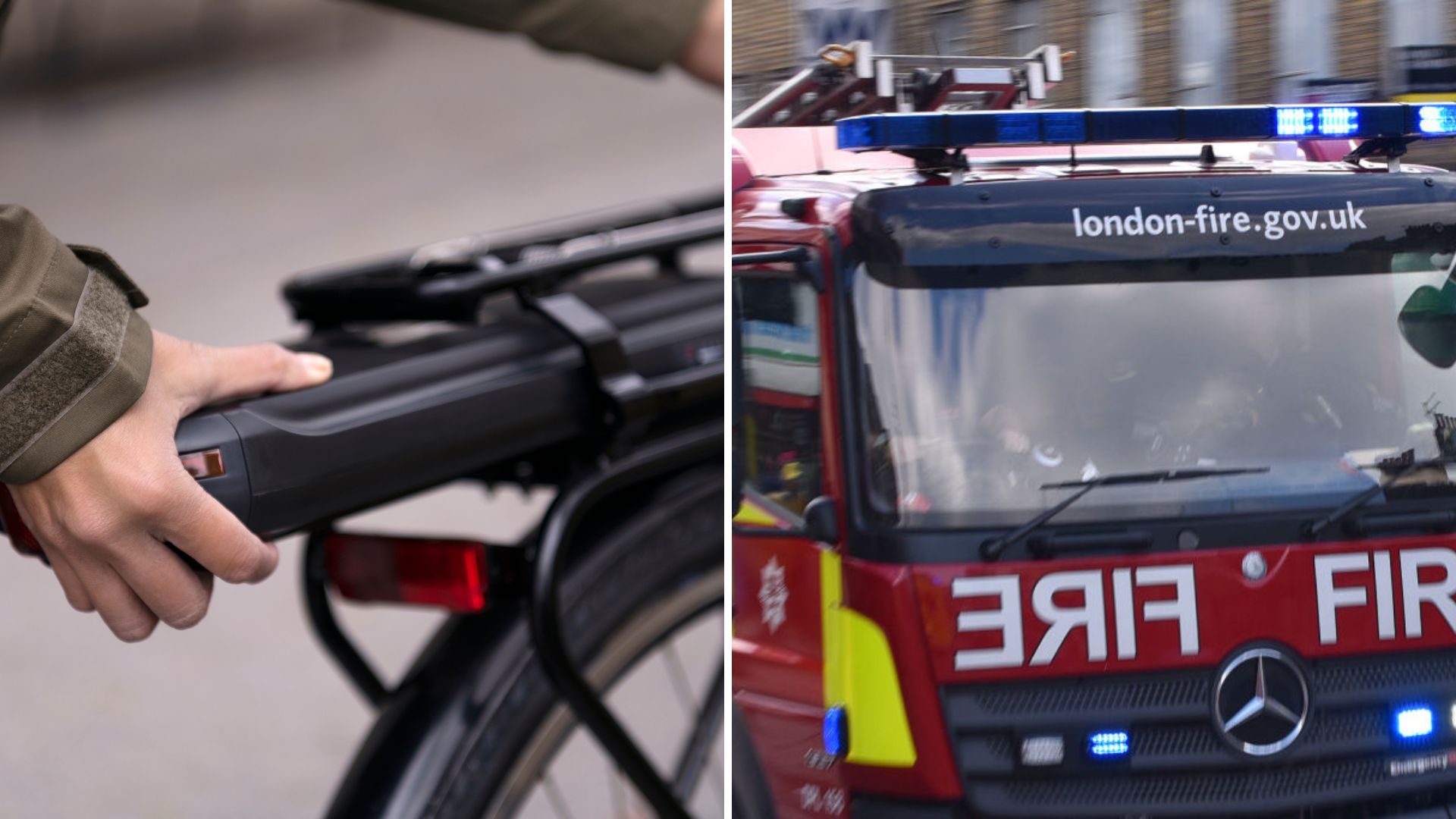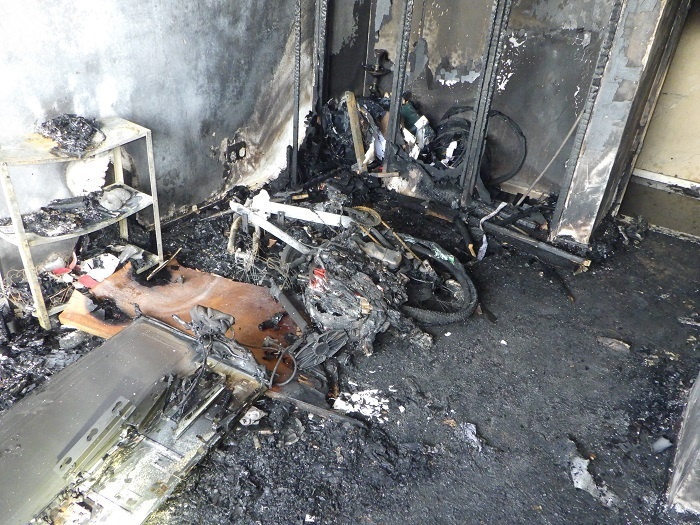
“Searching for the trapped woman we were met with multiple explosions from the lithium-ion battery packs. The fire was everywhere, there were hot spots all over the ceiling and the temperature was so intense I could feel it through my gloves.”
As the owner of an e-bike, this horrific testimony from London firefighter Paul Fergus gets my full attention. We have two e-bikes in our household, my wife’s Liv Vall E+ Pro and my Specialized Creo. Both are kept in the house, though we’re nervous about charging them unattended. Is our caution justified? After all, even the UK Department for Transport’s latest guidance on e-bike safety concedes that all lithium batteries pose some risk.
Fanning the flames

When Andy Beaton bought his son an e-bike online for Christmas he never imagined it would almost cost him and his family their lives. It caught fire while charging overnight, but luckily Andy’s family escaped. He reckons the house was gutted within about four minutes.
Tragically, others in 2023 weren’t so fortunate. Sofia Duarte lost her life on New Year’s Day to an e-bike battery fire and in June, Scott Peden lost his partner and two young children after an e-bike battery he bought burst into flames.
“Last year, in London we had 155 e-bike and e-scooter battery fires,” says Charlie Pugsley, Assistant Commissioner for Fire Safety, London Fire Brigade. “Sadly, it was 2023’s fastest growing fire trend, which took three lives and injured 60.”
That’s almost a fire every other day, just in the UK's Capital. Figures for the whole of the UK are difficult to verify because record keeping differs between regions, but it’s reasonable to assume the issue is universal, and it's well documented in the US, too.
Both e-bikes and e-scooters are powered by multi-cell, lithium-ion battery packs that can suffer a potentially lethal malfunction known as thermal runaway. If a cell overheats, perhaps because misuse has caused a short circuit, or the pack is being charged at too higher voltage, an exothermic reaction can cause its structure to break down. The resulting intense heat can trigger neighbouring cells to breakdown too, initiating a rapid, irreversible runaway that’s characterised by fire, explosions and the escape of highly flammable gasses.
“I’m a fan of cycling,” says Pugsley, “but we must accept that any lithium-ion battery presents a risk. However, if we look at the reputable brands the level of that risk is certainly a lot, lot lower. The key causation trends are conversion kits, the use of incompatible chargers and riders making modifications.”
While there is an element out there, knowingly cobbling together illegal e-bikes from God knows what parts, much consumer behaviour is innocent.
“People commonly buy second-hand e-bikes with missing chargers or batteries from genuine sellers,” Pugsley tells me, “after all, we lose stuff all the time. Invariably, the buyer will turn to online marketplaces to source a replacement, mistakenly assuming they are purchasing the correct item.
“Consumers cannot be expected to be technical experts, so we need clear safety standards around conversion kits, chargers and batteries. For example, a standard that prevents people plugging a 48 Volt battery into a 96 Volt charger will greatly reduce the risk of a fire. Currently, the Office for Product Safety and Standards is consulting on this very area. We’ve helped them with fire investigation data and are awaiting the outcome.”
Many urban households, with no access to outdoor storage, default to storing and charging e-bikes in the main hallway. This can be a death-trap warns Pugsley.
“Our current response time is six minutes for the first fire engine to attend,” says Pugsley, “but even if we were the fastest service on Earth, you’ve still got an immediate fire blocking your escape. To stay safe, store and charge them away from a main exit and follow the recommendations in our #ChargeSafe campaign.
Are the big brands safer?

One night in early August 2023, firefighter Paul Fergus and his crew received news of an apartment fire just off Kilburn High Street, with a woman reportedly trapped inside. They reached the site within just four minutes.
“The powerful explosions that me and my partner Zafer Nadji encountered on entering the flat on the third floor felt like the utilities going off,” said Fergus. “They were actually the individual cells within the battery packs of three e-scooters exploding like shotgun cartridges.
“We moved to the bathroom, which is where we found the woman, conscious and breathing but unable to move. I picked her up while Zafer tried to clear an egress route through a great deal of flammable clutter. The heat was so extreme that our exit point kept re-igniting but eventually we got down the staircase to fresh air. The fire was so hot it self-extinguished after the windows melted.”
Paul Fergus and his partner Zafer Nadji both received commendations for their part in the rescue, awarded by Camden Borough Commander David George.
Are there any differences between bikes from the big, well-established brands and the components you can buy from AliExpress? Is my Specialized Creo safer, as Pugsley intimated, than a cheap kit I could have built myself?
“There are a number of safety standards already in place for complete e-bikes,” says Marco Sonderegger, Director, Turbo Product Experience at Specialized. “However, we’ve chosen to go beyond current legal requirements by voluntarily complying with more, including UN38.3, EN50604, EN15194, ISO13849 and UL2271. All the major components – motor, battery, charger and so on – are designed and developed as a cohesive system by Specialized engineers here at our e-bike development centre in Cham, Switzerland.”
“Our e-bikes are engineered with sophisticated controllers,” adds System Architect Lucie Hornikova, “to stop thermal runaways occurring. If our Battery Management System (BMS) software senses a symptom, such as overcharging, overheating or a short circuit, then the controller will shut the whole system down. It works on a cell-by-cell level, to stop an issue propagating, a level of protection that third party components do not have.”
“If you connect the wrong charger,” says Sonderegger, “or try to wire up a third-party battery, the system will just laugh at them. The bike won’t respond. Similarly, our e-bikes won’t charge if the environmental conditions – intense heat or cold – aren’t right, plus our battery packs are protected against water and dust ingress to safeguard against damage and potential short circuits.”
I put it to Sonderegger that many riders wouldn’t be tempted to buy from online marketplaces if the genuine branded components weren’t so pricey. “Our kit is more expensive because all the safety requirements are difficult to meet,” he says. “Paying for our facility here, our expert team, the testing, it all costs money. It’s reassuring that, because of the investment we make, these cheap, rogue solutions won’t work with our products.”
Of course, proprietary systems are a double-edged sword. Wouldn’t it be safer if there was universal compatibility between brands and systems?
“I can’t foresee a time when batteries can be swapped between brands,” says Sonderegger, “because their motors may be working to different voltages, which a battery needs to match. It would stifle innovation too. However, I would be interested in a solution where our bikes can be fast charged with a Specialized charger, but slow charged via a generic standard.”
In fact, the CHAdeMO EPAC standard introduced last year aims to achieve just this, primarily to facilitate common charging infrastructure in public spaces while maintaining the safety features of proprietary systems.
Harmonious components
Bosch doesn’t make e-bikes, yet the brand is ubiquitous in the market. How does it ensure that its components remain safe when fitted to the likes of Canyon, Cannondale, Lapierre, Scott and so on?
“We offer only complete systems to our partner brands,” confirms Claus Fleischer, CEO of Bosch e-bike Systems. “The Bosch e-bike system consists of the drive unit, battery and display, supplemented by digital services and apps. Perfectly harmonized components.”

Just like Specialized’s products, Bosch’s systems include a BMS, and its battery cells have safety mechanisms that cut flow to surrounding cells in the event of an issue. The cells are also encased in flame-retardant plastic that provides mechanical and thermal isolation from the rest of the battery pack.
“In addition to our own tests, we also commission external accredited laboratories to verify compliance with standards such as UN-T,” responds Fleischer when I ask about legislation. “Regulation exists, but the real challenge for authorities is ensuring enforcement.”
Lithium-ion technology dates to the early 1990s. I suggest that safer solutions must be on the horizon.
“Lithium-ion technology is currently the optimal energy source,” says Fleischer. “However, we are working with suppliers to identify new technologies. Solid-state batteries are promising, although they have not yet reached sufficient maturity. There are other technologies too, such as sodium-ion batteries and lithium manganese iron phosphate (LMFP) chemistry.”
Standards save lives

Giuseppe Capanna, Product Safety Engineer at Electrical Safety First, the campaigning charity for electrical safety, wants three issues to be addressed urgently. First, online selling platforms need to be held to account.
“Online sellers such as Facebook Marketplace, Amazon, eBay, AliExpress and so on don’t follow the same rules as the High Street brands. Their stance is that they’re not selling these items, instead they’re just providing a platform for third-party sellers. While most of them are quite good at removing dangerous items, none of them are proactive about it, instead waiting for us or the public to inform them.”
Second, independent testing must be compulsory. Capanna tells me that it’s common for rogue electrical goods to be accompanied by declarations of conformity when no testing has been performed.
“That’s why we need legislation that makes it mandatory for anyone who sells an e-bike or e-scooter to get third party certification,” says Capanna. “The reputable brands are already doing this, they’re getting their products tested. It's the rogue sellers the public needs to be protected from.”
Lastly, Capanna wants new safety standards introduced for e-bike conversion kits, including a stipulation that consumers must easily be able to identify the correct battery and charger for any motor or control system.
Capanna welcomed the Office for Product Safety & Standards’ decision in January to take enforcement action – the first of its kind – against the online sellers listing a dangerous e-bike battery identified by the name UPP.
The bottom line: are e-bike batteries safe?
So, are e-bike batteries safe? Yes, provided you buy from reputable sources that sell reputable products. I’m reassured by the lengths that brands such as Bosch and Specialized go to in order to safeguard my loved ones, my property and, let’s be realistic, their reputations. At the same time, I’m horrified that potentially lethal products can be sold online with scant regard for public safety. The phrase ‘buyer beware’ has never been more apt.







